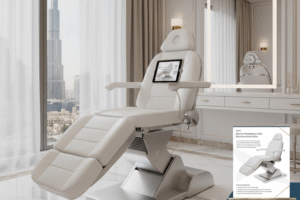
Best Oxygeneo Machine in the UAE: GeneO+ 3 in 1 Facial Device
In today’s competitive aesthetic market, dermatology clinics and skincare centers across the UAE need more than just skilled professionals; they
More Posts

In today’s competitive aesthetic market, dermatology clinics and skincare centers across the UAE need more than just skilled professionals; they

In a busy dermatology clinic, the right chair can make all the difference in efficiency, comfort, and treatment outcomes. Yet
Send Us A Message
Understanding the different Types of Derma Chairs is a critical step for dermatology and aesthetic clinics aiming to optimize patient care and procedural efficiency. While many clinics invest heavily in advanced dermatology equipment, the mismatch between chair design and actual clinical requirements often results in operational inefficiencies and unnecessary costs.
By analyzing the various exam chair types, their mechanisms, and their suitability for specific treatments, clinics can make evidence-based decisions that enhance patient comfort, support clinical staff, and ensure long-term value.
This article examines the various types of dermatology chairs and their practical applications in skin treatments, enabling readers to make informed purchase decisions, avoid costly mistakes, and future-proof their investment.
Dermatology chairs are classified into two main categories based on adjustment mechanism and procedure type. By adjustment mechanism, there are five derma chair types: manual, swivel, hydraulic, electric, and fully automatic chairs, each offering different levels of precision and ease of use.
By procedure type, derma chairs are divided into advanced models, perfect for hair transplants, laser treatments, and surgical procedures, and mid-level chairs, commonly used for general exams, facials, and aesthetic treatments.
This classification helps practitioners evaluate which chair best aligns with their clinical usage, treatment needs, and patient flow, enabling them to improve practitioner ergonomics, enhance patient comfort, and achieve a smoother workflow and better clinical outcomes.
➕ Read more about: Top Dermatology Equipment for Every Modern Skincare Clinic

Dermatology chair types by adjustment mechanism are classified into five main categories: manual, swivel, hydraulic, electric, and fully automatic. In essence, the adjustment mechanism determines how easily practitioners can position patients, which in turn directly impacts treatment accuracy, staff effort, and overall patient comfort.
To begin with, manual derma chairs rely on simple levers or pumps for basic positioning, while swivel and hydraulic models add flexibility and smoother adjustments. Moving further, electric derma chairs use motorized controls for higher levels of precision, and fully automatic chairs deliver advanced programmability for complex procedures. Ultimately, each type varies in cost, functionality, and application. The following subsections explore these derma chair types in detail.
A manual procedure chair is a basic, often manually operated, dermatology examination chair for basic skin treatments, offering manual adjustments for height and backrest, unlike more advanced electric models. It serves as a functional and affordable option for small clinics and general treatments such as acne diagnosis and basic skin cleaning, providing essential patient support without the motorized features of premium chairs.
🔶 Pros: Affordable and reliable; No dependence on electricity.
🔶 Cons: Limited adjustments compared to advanced systems; Can be less efficient for complex procedures.
🔶 Typical Use Cases: Manual chairs are best suited for general derma exam chairs, lighter treatments, and as backup chairs in busy clinics.
🔶 Specifications and Limitations:

Manual Examination Bed – DP-8219 from Skyline Med. This derma bed provides strong stability, high-density padding, and versatile use across beauty, massage, and wellness procedures.
Swivel semi-adjustable dermatology chairs are a type of medical or aesthetic treatment chair that combines basic rotation (swivel) capability with limited adjustment functions. They are designed to provide moderate flexibility for both the practitioner and the patient — more than a fixed chair, but less than a fully motorized or multi-adjustable model.
In most cases, these chairs are operated using foot pedals or manual swivel rotation, which enables practitioners to reposition patients with minimal effort. As a result, they offer greater convenience than standard manual chairs while remaining cost-effective.
🔶 Pros: Great for smaller treatment rooms; Easier patient access due to swivel functions; Provides more flexibility than purely manual chairs.
🔶 Cons: Less advanced than fully motorized derma chairs; May not support highly complex procedures.
🔶 Use Cases: Commonly used as a procedure chair for dermatology, where space is limited and mobility is key.
A hydraulic derma chair uses gas or hydraulic pistons to enable smooth and controlled adjustments during procedures like facials and aesthetic treatments. They work by allowing practitioners to modify the chair’s height and tilt with minimal effort, often through a foot pedal or lever system. This mechanism provides greater precision and stability compared to standard manual chairs, making patient positioning easier and more consistent.
🔶 Pros: Smoother transitions than manual models; Strong, reliable structure.
🔶Cons: Limited in the number of adjustment axes; May require physical effort for fine positioning.
🔶 Common Uses: Popular in mid-range clinics for dermatology examination chairs and aesthetic treatments.

Hydraulic Beauty Chair – DP-8222 (2,500 AED). This Skyline Med model offers hydraulic height and tilt adjustment, 360° rotation, and movable armrests, making it a versatile choice for clinics and spas
Motorized dermatology chairs are advanced treatment chairs that utilize built-in motors (ranging from 2 to 4 motors) to adjust the height, backrest, leg rest, and tilt with precision. They operate through user-friendly control interfaces, such as hand remotes, foot pedals, and in some models, memory presets that allow practitioners to save and recall preferred positions instantly.
This motorized mechanism provides smooth, accurate, and effortless adjustments, which reduce staff fatigue and ensure optimal patient comfort.
🔶 Pros: High precision in positioning; Reduces strain on staff; Increases procedure efficiency and patient comfort.
🔶 Cons: Higher initial cost; Requires a power supply and maintenance.
🔶 Use Cases: Widely used for multi-functional derma chairs, facial treatments, and derma beds in advanced clinics.

Multifunctional Bed – 4 Motors DP-8195 (4,500 AED). Equipped with four silent motors, ergonomic padding, and CE certification, this chair is ideal for high-end aesthetic clinics and wellness centers.
Advanced surgical dermatology chairs are specialized chairs designed for operative and complex dermatology procedures. They operate using fully motorized systems that allow Trendelenburg positioning, full tilt, rotation, and multi-axis adjustments with precise control.
These automatic procedure chairs provide effortless and accurate positioning, enabling practitioners to focus entirely on the procedure while maintaining patient safety and comfort.
🔶 Pros:
🔶 Use Cases: Best suited for advanced skin clinics and hospitals offering surgical dermatology treatments or hair transplant procedures.
➕ Read more about: Top Dermatology Chairs: 10 exam chairs for Aesthetic Clinics and Skincare Centers in 2025
Dermatology chairs are generally categorized into examination chairs, aesthetic treatment chairs, and surgical or hair transplant chairs, depending on the procedure and functional requirements. Each type serves a different purpose and offers distinct levels of adjustability.
For example, hair transplant chairs are highly adjustable to enable precise positioning and patient comfort during long procedures, while general dermatology examination chairs and aesthetic treatment chairs are typically mid-level models that provide essential height and tilt adjustments suitable for shorter or less complex treatments.
Below are the main categories and their ideal chair types:
Hair transplant procedures typically last between 4 to 8 hours per session, requiring the chair to provide exceptional comfort and precision positioning throughout the treatment. These procedures demand full reclining capability, adjustable head tilt, and extended leg support to ensure patient stability and ease of access for the practitioner.
An ideal hair transplant chair should also rotate smoothly, offer a removable footrest, and preferably include memory presets that allow quick repositioning during different stages of the procedure.
In practice, electric or semi-electric derma chairs with ergonomic headrests are considered the most suitable options. At the same time, multi-functional models equipped with adjustable attachments deliver maximum flexibility, control, and procedural efficiency.
🔶 Special Features Needed:

Derma Chair D02W with 3 Motor, This procedure chair for dermatology offers smooth motorized adjustments, ergonomic design, and easy hand/foot controls — perfect for transplant sessions.
For lighter use, like skin checks, biopsies, or minor lesion removals that usually last between 15 and 45 minutes per session, clinics don’t need advanced features. A Dermatology exam chair with basic height adjustment and swivel functionality is often sufficient.
Clinics can opt for manual derma chairs for those on a budget, or hydraulic dermatology examination chairs that provide smoother operation and added comfort without the complexity or cost of fully motorized systems.
🔶 Special Features Needed:

2-Section Physical Therapy Bed – DB0300 (3,100 AED). With sturdy steel construction, electric height control, and durable upholstery, it works well as a dermatology bed and chair for general exams.
Facial procedures such as injectables, chemical peels, and advanced Hydrafacial
demand precise positioning, fine tilt control, comfortable headrests, and proper leg support to keep patients relaxed throughout sessions that typically last 30 to 90 minutes. For these treatments, electric dermatology beds and chairs are ideal, as they allow small, controlled adjustments with ease.
The best options for such procedures are electric derma chairs with 3-motor systems that deliver smooth, precise movement, or multi-functional derma chairs that combine versatility, comfort, and adjustability for a wide range of aesthetic procedures.
🔶 Special Features Needed:

Beauty Examination Chair – DP-8294, Perfect for facials and body treatments, offering three electric motors for height, back, and leg rest adjustments.
Surgical dermatology procedures such as excisions and minor surgeries under local anesthesia require maximum stability, Trendelenburg positioning, and secure safety locks.
For these advanced needs, the most suitable choices are fully automatic surgical treatment chairs designed for operating precision and multi-axis motorized derma beds with certified safety features that ensure both patient security and practitioner efficiency.
🔶 Special Features Needed in Surgical Chairs:

Multifunctional Electric Bed – 4 Motors DP-8394C (4,800 AED). CE-certified, with independent motor control for height, back, leg tilt, and Trendelenburg, this dermatology equipment is ideal for surgical procedures
Laser procedures like tattoo removal or Laser hair removal require a procedure chair for dermatology that exposes the target area, reduces shadowing, and allows adjustable height for optimal laser positioning.
The best solutions in this category are mid-range electric derma chairs with adjustable tilt and leg positioning, as well as models designed with U-shape cutouts or ergonomic access points to accommodate laser arms and ensure seamless treatment delivery.
🔶 Special Features Needed in Laser Treatments Chairs:
➕ Read more about: Best Dermatology Equipment Supplier in UAE

Manual Examination Bed – DP-8219 from Skyline Med. This derma bed provides strong stability, high-density padding, and versatile use across beauty, massage, and wellness procedures.
When choosing among types of dermatology chairs, focus on features that maximize comfort, safety, and efficiency. Here are five essential considerations:
➕ Read more about: Importance of Derma Chair: Enhancing Comfort and Precision in Cosmetic and Laser Treatments
Choosing the right types of derma chairs requires balancing the chair’s mechanism, procedure needs, and essential features. By focusing on comfort, adjustability, stability, and hygiene, clinics can ensure both patient satisfaction and staff efficiency while making a long-term, reliable investment.
Make informed decisions for your practice and explore the latest viral and highest quality dermatology equipment at Skyline Med- the best medical devices store in the UAE!
What are the Differences Between Electric and Manual Derma Chairs?
Differences between electric and manual derma chairs are primarily in the power mechanism, control precision, and the level of comfort they offer during dermatology and aesthetic procedures.
Electric derma chairs operate with motorized controls for smooth, precise adjustments in height, tilt, and position, offering superior comfort and efficiency during long or complex treatments.
In contrast, manual derma chairs rely on hydraulic or mechanical levers, providing only basic movement control suitable for short, routine procedures.
How to choose a derma chair?
To choose a derma chair, consider the chair’s mechanism–manual or electric, procedure requirements, and essential features, ensuring it provides the right adjustability, comfort, stability, and precision for your clinic’s specific treatments.
When Manual Derma Chair a Good Choice?
A manual dermatology chair is a good choice for small clinics, those with high patient volumes, or for facilities prioritizing durability and cost-effectiveness over advanced electronic features.